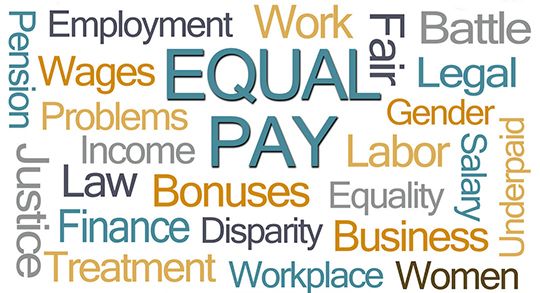
Co-Authored with Kevin Miller, Ph.D.
Imagine for split second a world where the jobs that women do are as valued as the jobs that men do. Mothers wouldn’t be penalized for having children. Men would gladly take paternity leave. Salary negotiations would be a breeze. The two extra hours of chores that women do every week would be eliminated. Women would enter higher-paying STEM fields in droves. And the debate over the wage gap is would be settled.
Unfortunately, we’re not there. Today is Equal Pay Day, the day that marks how far into each calendar year women have to work in order to earn the same amount men earned the year before. Not only are we not there, but any conversation about the wage gap almost inevitably leads to a chorus of denial which see-saws between people arguing about the existence of the gap and asserting that, if it does, it’s primarily due to women’s choices. Closing it, wage gap deniers say, is simply a matter of women making different choices.
If only.
The wage gap is well documented, enduring and racialized. In the U.S. women working full-time, year-round typically were paid 80 cents for every dollar paid to men working full-time, year round in 2015. The gap was even larger when accounting for race: relative to every dollar paid to white men, African-American women were paid 63 and Hispanic women were paid 54 cents. Measured against this standard means that for Black women Equal Pay Day is actually August 23rd and for Latina Women it’s November 1st. These data come from the U.S. Census Bureau’s Current Population Survey, a rigorously-analyzed national survey and has been documented and studied repeatedly.
Economists and analysts understand that the wage gap results from several overlapping and knotty issues. Women’s greater responsibility for care work means they work more part-time; the jobs that women tend to gravitate towards have lower average salaries; “men’s work” is more highly valued in the economy; employers don’t respond well to women asking for raises; and, yes, actual old-fashioned apples-to-apples wage discrimination is still happening.
Among the most common reason given to dismiss the gap is that it stems from women’s choices to work part-time and to women’s natural preference for lower paying jobs. The argument handily ignores the cultural, economic and institutional contexts in which women make their decisions.
“Wage gap deniers ignore the cultural, economic and institutional contexts in which women make their work decisions.”
Subject area interests, which feed choices of college majors and job selections, are shaped in childhood by adult biases, stereotypes and stereotype threats, cementing salary paths long before anyone is thinking about them. In addition, women are still assumed to be default parents whose income is, in theory, supplemental, despite 38% of households now relying on women’s as primary income earners. The desire to mother, according to deniers, usually overrides other needs and ambitions. However more, not fewer, women want to be working. According to Pew Research conducted in 2012, however, 32% of mothers with children said they would prefer to work full-time but could not afford to, an increase from 20% in 2007. The decision to work part-time, or in a profession that provides “flexibilty,” isn’t a choice but an imposed necessity related to gender role expectations and inadequate workplace policies. Neither the resulting “motherhood penalty” nor the “fatherhood bonus” are within any one woman’s control. Even when they make the same choice, to start a family, women and men’s paychecks move in opposite directions: Women are paid less on average after becoming mothers; fathers are paid more.
Women and their pay are grossly disproportionately negatively affected. Dismissed, these realities ensure that the workplace remains highly segregated into jobs for men and jobs for women, valued hierarchically.
This division of labor, what researchers call occupational segregation, is a major factor in the pay gap. It’s important to recognize that doctors and nurses, cashiers and their managers, executives and their assistants are all part of the calculation that gets us to the overall wage gap number. It may not be surprising that doctors make more than nurses because they have more education and training. But these types of distinctions do not explain most differences. Not all occupational pay differences can be explained by education, training or responsibilities: For example, parking lot attendants (86 percent of whom are men) are paid more than childcare workers (97 percent of whom are women).
Wage gap deniers deliberately overlook that even when women make the same choices as men, a gap is still measurable. When women do make different choices and, in search of higher wages, and they enter occupations traditionally dominated by men, studies show that average wages in those sectors drop. The opposite happens when men move into a sector. In other words, it’s not the jobs that make the salaries higher, it’s the fact that men are doing them.
A study by Cornell economists found that, even after statistically controlling for factors like occupation, work hours, parental status, and education, a significant, unexplained earnings gap remains. Researchers conclude that this remaining gap is at least partially the result of gender bias and discrimination.
“Even when women make the same choices as men, a gap is still measurable.”
Most importantly, however, objections to the validity of the gap critically hinge on erasing the question of why certain jobs are valued so much more highly than others. Closing the wage gap is not actually about getting women to work more hours or to do “men’s” jobs, it’s about valuing work that has traditionally been done by women, including, notably, unpaid care work, the provision of which by women continues to be a significant drag on parity in the workplace and wages.
Individual women can’t close the wage gaps that shape our lives. That requires systemic changes that many are willing to ignore, so don’t let off the hook.
Equal pay policies aren’t only fair and good for women and their families. Studies show that equality is good for business. When people believe they are paid fairly, they tend to be productive workers with longer retention. Companies that know what’s best for the bottom line are now publicly pledging to address gender pay disparities.
No matter how you slice and dice the numbers, a gap exists. The question is what can we do about it. Left on its own, it is estimated that the gender wage gap won’t close for another 135 years. With families depending on mothers’ paychecks more than ever before, we can’t afford to cherry pick wage gap statistics in an endless game of whack-a-mole. Once we accept the difficult truth that women are forced to absorb more costs and live on less than men, it will put us one step closer to creating a world where everyone, regardless of gender, is getting fair pay at work. We owe it to the next generations and ourselves.
______________________________________
Kevin Miller is a senior researcher at AAUW. He has authored publications, testified before state and city lawmakers, conducted technical assistance, and analyzed data on a wide variety of topics, ranging from the gender wage gap to implicit bias.
